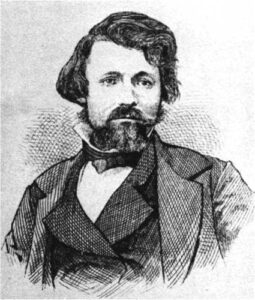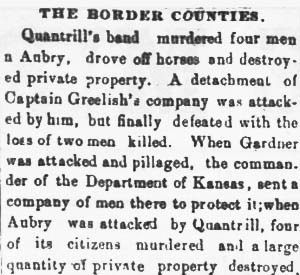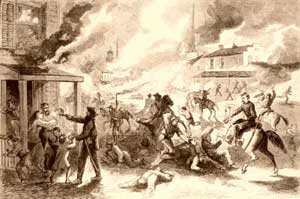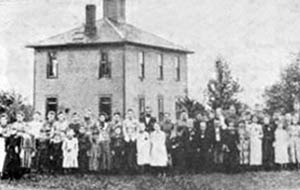
Aubry Cemetery, Johnson County, Kansas, courtesy Google Maps.
Aubry, Kansas, located in southeastern Johnson County was once a bloody battleground during the border troubles of the Civil War.
Aubry Township was organized by the County Commissioners on May 11, 1858. Previous to this time, a large number of settlers had taken claims in the area, the first of whom was William H. Brady, who selected his claim on February 22, 1857.
In March 1858 the townsite of Aubry was surveyed and a Town Company was organized. The company was composed of A. J. Gabbart, President; Greenbury Trekle, Secretary; William H. Brady and Felix Franklin.
Located along the Oregon and Santa Fe Trails, the new settlement was named for Francois Xavier Aubry, a famous Santa Fe trader. A military road that connected Fort Leavenworth to Fort Scott also passed through the area
The first school district was organized in the summer of 1858 and a 20×24 foot schoolhouse was built. Its first teacher was Sylvester Mann. The building also served as a church and social center until those buildings were built the following year. Reverend Duval preached the first sermon in February 1858 in A. J. Gabbart’s house. The first church organized was of the Christian denomination, in May 1859, by Reverend A. Clark. The post office was established on June 21, 1860.
Though the village had a promising start, trying times were coming to Johnson County. When the Civil War erupted in 1861, peace came to an abrupt end, and many men left to become soldiers.
Troubles had been broiling between Kansas and Missouri for years during the Bleeding Kansas days when Free-State men fought pro-slavery advocates to decide whether Kansas would become a slave state or a free state. Just months before the war broke out, Kansas had officially entered the Union as a free state and tensions were still high along the border.
William Quantrill, leader of the guerilla band Quantrill’s Raiders, often traveled along the Military Road, pillaging and raiding area towns multiple times throughout the war.
On March 7, 1862, Quantrill raided Aubry, killing three men, looting the town, driving off horses, and destroying considerable property. The people of Aubry buried the three men under three cedar trees. This area became the Aubry Cemetery the same year.
As a result, Captain John Greelish led Company E of the 8th Regiment of Kansas Volunteers to Aubry to set up a post on March 10. Two days later, the soldiers won a skirmish near Aubry with about 30 of Quantrill’s men. After this, an additional company of troops was sent to Aubry and Major E. F. Schneider then took command. The town was then garrisoned by Union troops intermittently for the rest of the Civil War.
Perhaps due to the violence in the area, Aubrey’s post office closed on July 17, 1862.
Later that year, Company D of the 11th Kansas Infantry, under command of Lieutenant Dick Rooks, manned the post at Aubry. Rooks was a Red Leg and a Jayhawker. This company remained at Aubry through the winter of 1862-63.
Later in 1863, Captain Joshua A. Pike led 72 men, composed of two companies of cavalry to Aubry.
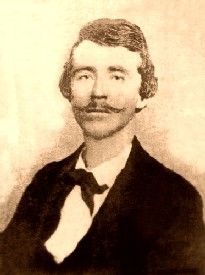
William Quantrill
Captain Charles F. Coleman, Ninth Kansas Cavalry, was the commander of the garrison at New Santa Fe, Missouri in August of 1863. He was notified at 8:00 p.m. by Captain Pike in Aubrey, Kansas that a large guerrilla force had passed about five miles south of Aubrey headed into Kansas.
On the afternoon of August 20, 1863, at about 3:00 p.m, William Quantrill passed within sight of the post with about 400 guerrillas and Confederate Army recruits. These men were on their way to raid Lawrence, Kansas. Though Pike formed his men into a battle line south of his post, he took no action to determine the identity of Quantrill’s men or to pursue them once he suspected they were guerrillas. He passed the information about the travelers to all the troops in the area, but he did not notify his superiors about them in a timely manner.
Captain Charles F. Coleman, in command of the post at Little Santa Fe, Missouri, was not informed until 8:00 p.m. By 9:00 p.m. Captain Coleman marched with 80 cavalrymen to Aubry. Around 11:00 p.m. he joined up with Pike’s 100-strong force at Aubry and the troops set out after Quantrill. Tracking the guerillas at night was difficult and Quantrill was so far ahead of them that the pursuers could not possibly catch him.
Making matters worse is that Greenbury Trekle’s father, an 80-year-old man, who lived in Missouri six miles east of Aubry had previously warned authorities at the Aubry post that Quantrill was planning a raid on the city of Lawrence. When he got to Aubry, the officer in charge did not take old man Trekle seriously and nearly 200 people lost their lives in the Lawrence Massacre on August 21, 1863. Later, when Quantrill’s men heard that Trekle had informed the officer of their plans, they killed him.
“Disaster has again fallen on our State. Lawrence is in ashes. Millions of property have been destroyed, and, worse yet, nearly 200 lives of our best citizens have been sacrificed. No fiends in human shape could have acted with more savage barbarity than did Quantrill and his band… I must hold Missouri responsible for this fearful, fiendish raid… Such people cannot be considered loyal, and should not be treated as loyal citizens.”
Thomas Carney, Kansas Governor
Pike did not remain at Aubry much longer, but from August 1863 to at least September 1864 one to two companies of the 11th Kansas Cavalry was on duty guarding Aubry.
Quantrill’s Raiders also made others raids in and around Aubry in 1863. On one occasion, five newly arrived citizens were out gathering honey one evening, promising their wives to return early. However, Greenbury Trekle, a Mr. Whittaker, Washington Tullis, Mr. Ellis, and John Cody, were murdered by Quantrill’s men.
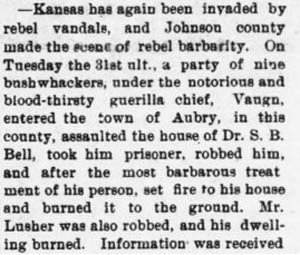
Aubry newspaper clipping, Olathe Mirror, 1864.
Union sympathizer, Dr. S. Bell’s house was surrounded by nine bushwhackers under Dan Vaughn who took him prisoner, assaulted and robbed him and set his home on fire. A Mr. Susher was also robbed and his house was burned. Numerous fights occurred over the years between Quantrill’s men and the people of Aubry, resulting in a lot of property damage.
On January 31, 1864, Norman Sampson was murdered by Dan Vaugh’s men, who were dressed in Union blue and professed to be Union soldiers.
Sometime after September 19, 1864, very possibly during the height of Price’s Missouri Raid, the garrison at Aubry was removed. This resulted in another raid by about ten guerrillas under Dan Vaughn on January 31, 1865. Word of the impending raid reached authorities in Olathe and a squad of soldiers rushed into Aubry, arriving too late to prevent the killing of a traveler, the robbery of two residents, and the burning of several houses. Once again about 20 soldiers were stationed at Aubry and the post remained active until at least May 1865.
With the war finally over and the area recuperating, Aubry’s post office opened again on June 19, 1866.
At this time, railroads began to expand across Kansas the Missouri Pacific Railroad Company was planning to build a track from Kansas City to the South. The initial plan was to build through Aubry, Kansas, which would have secured the small town’s future. However, when the area was surveyed, the railroad was concerned about the hills north of Aubry and the Missouri Pacific Railroad company decided to build their tracks half a mile east of Aubry in what would eventually become Stilwell, Kansas.
With the arrival of the railroad in Stillwell, the nearby town was an immediate rival to Aubry. The Aubry general store moved and many of Aubry’s residents soon moved to Stilwell for a fresh start. On June 22, 1888, Stilwell, Kansas, established a post office and two months later, Aubry’s post office closed on August 20, 1888. In the next years, what was left of Aubry merged with Stilwell.
Today, most of Aubry’s old townsite is buried beneath the streets and highways of Overland Park, Kansas. All that is left is the Aubry Cemetery, located between U.S. Highway 69 and Metcalf Avenue, south of W 191 Street.
©Kathy Alexander/Legends of Kansas, January 2022.
Also See:
Kansas Ghost Town Photo Galleries
Sources:
Civil War on the Western Border
Cutler, William G; History of Kansas; A. T. Andreas, Chicago, IL, 1883.
Edwards, Nick; Aubry, Johnson County, Lost Kansas Communities, Chapman Center for Rural Studies, Kansas State University, 2015
Steed, Laura; Ghost towns of Johnson County, 1973, unknown publisher
Wikipedia

